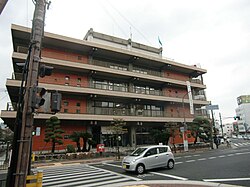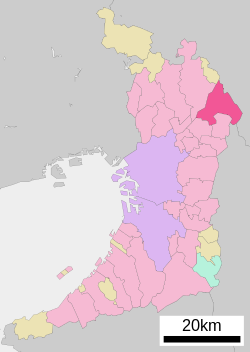Hirakata(Mai phương thị,Hirakata-shi)is acityin northeasternOsaka Prefecture,Japan.[2]As of 31 December 2021[update],the city had an estimatedpopulationof 397,681 in 183075 households and apopulation densityof 6100 persons per km2.[3]The total area of the city is 65.12 square kilometres (25.14 sq mi).[3]
Hirakata
Mai phương thị | |
|---|---|
 Hirakata City hall | |
 Location of Hirakata in Osaka Prefecture | |
| Coordinates:34°49′N135°39′E/ 34.817°N 135.650°E | |
| Country | Japan |
| Region | Kansai |
| Prefecture | Osaka |
| Government | |
| • Mayor | Takashi Fushimi[1] |
| Area | |
• Total | 65.12 km2(25.14 sq mi) |
| Population (December 31, 2021) | |
• Total | 397,681 |
| • Density | 6,100/km2(16,000/sq mi) |
| Time zone | UTC+09:00(JST) |
| City hall address | 2-1-20 Ogaito-chō, Hirakata-shi, Osaka-fu 573-8666 |
| Climate | Cfa |
| Website | Official website |
| Symbols | |
| Bird | Common kingfisher |
| Flower | Chrysanthemum |
| Tree | Willow |

Geography
editHirakata is located in northeastern of Osaka Prefecture, almost halfway between the metropolis of Osaka and Kyoto. It is on the left bank of theYodogawa River,and forms a triangle of 12.0 km (7.5 mi) and 8.7 km (5.4 mi) north–south. It is bordered by theIkoma Mountainsto the east.
Neighboring municipalities
editKyoto Prefecture
Nara Prefecture
Osaka Prefecture
Climate
editHirakata has aHumid subtropical climate(KöppenCfa) characterized by warm summers and cool winters with light to no snowfall. The average annual temperature in Hirakata is 16.2 °C (61.2 °F). The average annual rainfall is 1,389.5 mm (54.70 in) with June as the wettest month. The temperatures are highest on average in August, at around 28.3 °C (82.9 °F), and lowest in January, at around 4.9 °C (40.8 °F).[4]
| Climate data for Hirakata (1991−2020 normals, extremes 1977−present) | |||||||||||||
|---|---|---|---|---|---|---|---|---|---|---|---|---|---|
| Month | Jan | Feb | Mar | Apr | May | Jun | Jul | Aug | Sep | Oct | Nov | Dec | Year |
| Record high °C (°F) | 17.7 (63.9) |
22.7 (72.9) |
25.1 (77.2) |
31.0 (87.8) |
33.3 (91.9) |
36.3 (97.3) |
39.8 (103.6) |
39.6 (103.3) |
37.1 (98.8) |
34.0 (93.2) |
26.8 (80.2) |
25.0 (77.0) |
39.8 (103.6) |
| Mean daily maximum °C (°F) | 9.3 (48.7) |
10.2 (50.4) |
14.1 (57.4) |
20.1 (68.2) |
25.2 (77.4) |
28.1 (82.6) |
31.9 (89.4) |
33.7 (92.7) |
29.3 (84.7) |
23.5 (74.3) |
17.5 (63.5) |
11.8 (53.2) |
21.3 (70.3) |
| Daily mean °C (°F) | 4.9 (40.8) |
5.5 (41.9) |
8.9 (48.0) |
14.4 (57.9) |
19.4 (66.9) |
23.1 (73.6) |
27.1 (80.8) |
28.3 (82.9) |
24.3 (75.7) |
18.4 (65.1) |
12.5 (54.5) |
7.2 (45.0) |
16.2 (61.2) |
| Mean daily minimum °C (°F) | 1.0 (33.8) |
1.3 (34.3) |
4.2 (39.6) |
9.1 (48.4) |
14.4 (57.9) |
19.1 (66.4) |
23.4 (74.1) |
24.4 (75.9) |
20.4 (68.7) |
14.2 (57.6) |
8.1 (46.6) |
3.2 (37.8) |
12.0 (53.6) |
| Record low °C (°F) | −6.2 (20.8) |
−7.1 (19.2) |
−4.4 (24.1) |
−1.1 (30.0) |
3.2 (37.8) |
9.0 (48.2) |
15.3 (59.5) |
16.4 (61.5) |
9.4 (48.9) |
3.1 (37.6) |
−0.6 (30.9) |
−3.9 (25.0) |
−7.1 (19.2) |
| Averageprecipitationmm (inches) | 49.8 (1.96) |
61.6 (2.43) |
106.2 (4.18) |
102.4 (4.03) |
139.1 (5.48) |
194.2 (7.65) |
183.8 (7.24) |
142.5 (5.61) |
158.6 (6.24) |
136.7 (5.38) |
70.5 (2.78) |
53.0 (2.09) |
1,389.5 (54.70) |
| Average precipitation days(≥ 1.0mm) | 5.5 | 6.7 | 9.6 | 9.7 | 10.0 | 12.0 | 11.7 | 8.6 | 10.2 | 8.9 | 6.6 | 6.2 | 105.1 |
| Mean monthlysunshine hours | 135.0 | 128.7 | 161.2 | 184.4 | 193.4 | 141.7 | 155.9 | 204.9 | 153.9 | 158.1 | 143.2 | 139.9 | 1,912.2 |
| Source:Japan Meteorological Agency[4][5] | |||||||||||||
Demographics
editPer Japanese census data,[6]the population of Hirakata rose rapidly in the 1960s and 1970s, and less rapidly since.
| Year | Pop. | ±% |
|---|---|---|
| 1920 | 23,714 | — |
| 1930 | 27,878 | +17.6% |
| 1940 | 39,306 | +41.0% |
| 1950 | 52,817 | +34.4% |
| 1960 | 80,312 | +52.1% |
| 1970 | 217,369 | +170.7% |
| 1980 | 353,358 | +62.6% |
| 1990 | 390,788 | +10.6% |
| 2000 | 402,563 | +3.0% |
| 2010 | 407,997 | +1.3% |
Eriko Aoki, author of "Korean children, textbooks, and educational practices in Japanese primary schools," stated that the city's location in proximity to bothOsaka CityandKyotocontributed to its population growth of ten times its previous size from around 1973 to 2013.[7]
Ethnic Koreans
editAs of 2013 the city has about 2,000ethnic Koreans.Most Hirakata Koreans,[8]including children of school age, use Japanese names.[9]Many Koreans in Hirakata operate their own businesses. Hirakata has the "mother's society" or "Omoni no Kai", a voluntary association of ethnic Korean mothers. It also has branches of theChongryonandMindan,Japan's two major Korean associations. Hirakata has no particular Korean neighborhoods.[8]There were about 3,000 ethnic Koreans in Hirakata in the pre-World War IIperiod. In the 1930s Hirakata Koreans, fearful of keeping their own jobs, had negative attitudes towards Osaka-based Koreans who were looking for employment after having lost their jobs. Military construction was the most common job sector of that era's Korean population.[8]Eriko Aoki stated that in 2013 there was still a sense of difference between the Koreans in Hirakata and the Koreans in Osaka.[8]
History
editThe area of the modern city of Hirakata was within ancientKawachi Province.The place name of "Hirakata" is very old, appearing in theKojiki,Nihon Shokiand other ancient texts. During theAsuka period,the early Buddhist temple ofKudara-deraindicates the settlement of many immigrants fromBaekjein theKorean Peninsulafrom an early time. During theHeian period,the hills from Katano to part of Hirakata were called "Katano ga Hara" and were a hunting ground for the imperial family and were famous for cherry blossoms. The Osaka Kaidō, an extension of theTōkaidōhighway passed through the area, and in theEdo PeriodHirakata-jukudeveloped as apost stationon the highway and a river port on theYodo River.
The Hirakata Town was established with the creation of the modern municipalities system on April 1, 1889. Hirakata was elevated to city status on August 1, 1947. On April 1, 2001, Hirakata was designated as aspecial city of Japan.On April 1, 2014, Hirakata became a Core city with increased local autonomy.
Government
editHirakata has amayor-councilform of government with a directly elected mayor and aunicameralcity council of 32 members. Hirakata, together with neighboring Katano, contributes four members to theOsaka Prefectural Assembly.In terms of national politics, the city is part of Osaka 11th district of thelower houseof theDiet of Japan.
Mayors
edit- Sōichirō Terashima (in office 1947 – 1955, 1959 – 1967) former mayor of Hirakata-chō
- Harufumi Hatakeyama (1955–1959)
- Tomizō Yamamura (1967–1975)
- Kazuo Kitamaki (1975–1991)
- Kazuo Ōshio (1991–1995)
- Hiroshi Nakatsuka (1995–2007)
- Osamu Takeuchi (2007–2015)
- Takashi Fushimi (2015–present)
Economy
editHirakata's modern industry began with the munitions industry supplying to theImperial Japanese Armyand numerous civilian textile and clothing manufacturers. In early March 1939, a site associated with the arms industry blew up, killing 500 people.[10]In the post-war era, the former munitions plants were transformed intoindustrial parks,or public housing complexes to support Hirakata's growth as acommuter townfor Osaka and Kyoto. Textile and clothing production remain major industries in Hirakata.
Companies with offices in Hirakata
edit- KomatsuOsaka plant
- Sanyo Electric CoR&D
Education
editColleges and universities
edit- Kansai Gaidai University
- Kansai Medical University
- National Tax College
- Osaka Dental University
- Osaka International University
- Osaka Institute of Technology
- Setsunan University
Primary and secondary education
editHirakata has 45 public elementary schools and 19 public middle schools operated by the city government and six public high schools operated by the Osaka Prefectural Department of Education, and one by Osaka City. There is also one private elementary school, two private middle schools and three private high schools. The prefecture also operates two special education schools for the handicapped.
Prefectural senior high schools
- Hirakatsuda High School(Đại phản phủ lập mai phương tân điền cao đẳng học giáo)
- Korigaoka High School(Đại phản phủ lập hương lí khâu cao đẳng học giáo)
- Osaka Prefectural Hirakata High School(Đại phản phủ lập mai phương cao đẳng học giáo)
- Osaka Prefectural Makino High School(Đại phản phủ lập mục dã cao đẳng học giáo)
- Osaka Prefectural Nagao High School(Đại phản phủ lập trường vĩ cao đẳng học giáo)
Municipal high schools
Private senior high schools:
Transportation
editRailway
editJR West–Katamachi Line (Gakkentoshi Line)
Keihan Electric Railway-Keihan Main Line
Keihan Electric Railway-Katano Line
Highway
edit- Second Keihan Highway
- National Route 1Daini Keihan Road (toll road)
- National Route 168
- National Route 170
- National Route 307
Internationl relations
edit- Shimanto, Kōchi,Japan, friendship city agreement since 1974 (with formerNakamuracity)
- Betsukai, Hokkaidō,Japan, friendship city agreement since 1987
- Takamatsu, Kagawa,Japan, friendship city agreement since 1987 (with formerShionoetown)
- Changning District,Shanghai, China, sister city agreement since 1987
- Logan City, Queensland,Australia, sister city agreement since 1995
Local attractions
edit- Hirakata Park,an amusement park that includes roller coasters made of wood.[11]
- Hirakata T-Site, containing aTsutaya bookstorewith 7-meter (23 ft) high bookshelves.[12]
- Kudara-deraruins
- Kinyakurumazuka Kofun
- Kuzuha BatterySite
Notable people from Hirakata
edit- Hikaru Nakamura,Japanese Americanchess player
- Janne Da Arc,Japanesevisual keirock band
- Iori Kogawa,JapaneseAV Idol
- Koichiro Yoshinaga,Japanese formerNippon Professional Baseballcatcher/infielder
- Airi Shimizu,Japanesegravure idol,actress and varietytarento
- Yuji Naka,Japanesevideo game programmer,designer,andproducerwho madeSonic the Hedgehog
- Satoshi Hashimoto,Japanese actor andvoice actor
- Nobukazu Takemura,Japanese musician and artist
- Haruto Shirai,Japanesefootballplayer
- Kenji Honnami,former Japanesefootballplayer
- Yuki Kuniyoshi,professional Japanesebaseball player
- Junichi Okada,singer, actor and member of popular Japanese boy bandV6
- Katsuhisa Inamori,former Japanesefootballplayer
- Midori,Japanese Americanviolinist andclassical musician
- Kenji Moriwaki,Japanese comedianand radio personality
- Masahito Noto,Japanesefootballplayer
- Hirofumi Mukai,Japaneseprofessional boxer
- Yohei Takeda,Japanesefootball playerandgoalkeeper
- Hisaya Morishige,Japanese actor andcomedian
- Yuji Hino,Japanese professional wrestler
- Yuka Ishii,Japanese writer
- Takayuki Fukumura,Japanesefootball player
- Yoshimitsu Takashima,Japanese politicianof theDemocratic Party of Japan,a member of theHouse of Councillorsin theDiet(national legislature)
- Takumi Ozaki,member ofINI (Japanese boy group)
- Hono Tamura,member ofSakurazaka46
- Keiya Sento,Japanesefootball player,currently plays forMachida Zelvia
References
edit- ^"Thị trường thất へようこそ | mai phương thị ホームページ".
- ^"Hirakata" at Britannica.com;retrieved August 28, 2013.
- ^ab"Hirakata city official statistics"(in Japanese). Japan. Archived fromthe originalon December 5, 2020.RetrievedMarch 6,2022.
- ^ab "Bình niên trị ( niên ・ nguyệt ごとの trị )".JMC.RetrievedMay 19,2021.
- ^ "Quan trắc sử thượng 1 - 10 vị の trị ( niên gian を thông じての trị )".JMC.RetrievedDecember 5,2018.
- ^Hirakata population statistics
- ^Aoki, Eriko. "Korean children, textbooks, and educational practices in Japanese primary schools" (Chapter 8). In: Ryang, Sonia.Koreans in Japan: Critical Voices from the Margin(Routledge Studies in Asia's Transformations).Routledge,October 8, 2013.ISBN1136353054,9781136353055. Start: p.157.CITED: p.169-170.
- ^abcdAoki, Eriko. "Korean children, textbooks, and educational practices in Japanese primary schools" (Chapter 8). In: Ryang, Sonia.Koreans in Japan: Critical Voices from the Margin(Routledge Studies in Asia's Transformations).Routledge,October 8, 2013.ISBN1136353054,9781136353055. Start: p.157.CITED: p.170.
- ^Aoki, Eriko. "Korean children, textbooks, and educational practices in Japanese primary schools" (Chapter 8). In: Ryang, Sonia.Koreans in Japan: Critical Voices from the Margin(Routledge Studies in Asia's Transformations).Routledge,October 8, 2013.ISBN1136353054,9781136353055. Start: p.171.
- ^Hugh, Byas (March 2, 1939)."Village Wiped Out in Japanese Blast"(PDF).New York Times.RetrievedOctober 1,2023.
- ^"Hirakta Park" at Osaka-info.jpArchivedSeptember 21, 2013, at theWayback Machine;retrieved August 28, 2013.
- ^Furutani, Kasey; Kail Imada."10 most beautiful bookstores and libraries in Japan".Time Out Tokyo.RetrievedMarch 6,2023.
External links
edit- Hirakata City official website(in Japanese)
- www.city.hirakata.osaka.jp.e.cu.hp.transer.com(in English)


